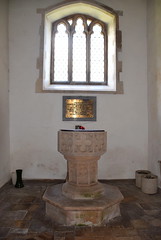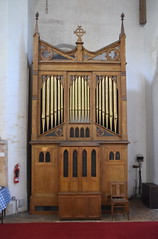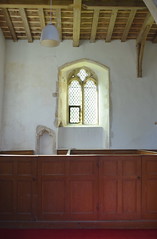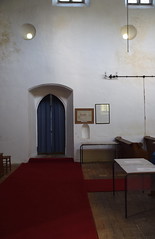| |
|
St
Margaret, Witton Noel
Coward's famous observation about the topography of
Norfolk may apply to the west of the county or the
marshland south and east of Norwich, but not here, near
the north east coast. The land builds to the coast,
swelling and rolling like waves, to be cut short into
cliffs by sea erosion. A couple of miles inland, St
Margaret sits in a cohort of trees on the brow of upland,
fields all around, hardly a house at all within a mile.
Most of the churches in this area had their round towers
replaced in the 13th and 14th century, but St Margaret
still retains an interesting one, as we will see.
Somewhat confusingly, Norfolk has two Wittons, both
remote, and both with churches dedicated to St Margaret.
The other one is Witton-by-Norwich, and this one is
sometimes referred to as Witton-by-Walsham to avoid
confusion. The church is an elegant, well-kept, peaceful
building, but it is also rather quirky. For example,
there are two splayed round windows in the lower north
side of the nave. Mortlock says they were uncovered by
the Victorians, which usually sets a few alarm bells
ringing, but here it seems reasonable to think that they
are genuine Saxon windows, and this is a genuine Saxon
piece of wall. As is the lower part of the south wall,
for both sides have long and short work ironstone blocks
forming the corners with the west wall. This wall was
clearly intended to be flat, and the tower is built
separately from the church. Because of this, we can
safely say that the body of the church was built before
the tower, which may be Saxon, but is probably early
Norman.
In the early 14th Century they began to expand the
church, but rather than rebuild it they heightened the
existing walls, which is why the tower and the church
still make an awkward juxtaposition even today. There is
a clerestory on both sides of the church, but an aisle
only to the south, contemporary with the clerestory,
rather than with the 15th century crowning of the tower
with a bell stage and battlements. Why no north aisle?
Perhaps it was never intended, but perhaps the Black
Death intervened, and lack of resources meant it was
never built.
When the Tudors extended the tower, they needed a way for
people to get up to the bell stage. Rather than build a
stairway inside the tower in the conventional manner,
they built a stair turret inside the church, against the
west wall of the nave, which is at once awkward and
intriguing. Tucked in beside the stair turret is a large
converted barrel organ. I remembered the late Tom Muckley
observing that small villages like this usually owned
just one barrel organ, which was used in the church on
Sunday and then moved to the pub for the rest of the
week. You hope they didn't get the tunes mixed up.
Otherwise, the hands of Georgians and Victorians are
responsible for the furnishings, although the bench ends
are actually cut down medieval ones, and there are some
fine early 18th century box pews in the aisle. The
sedilia set in the chancel is impressive, and would once
have been more so, but a 19th century window splay has
cut one of the seats and the original piscina away.
On the north wall of the chancel is the extraordinary
early 18th century monument to the wife of John Norris.
It couldn't be less symmetrical if it tried, and you can
just decipher the names on the spines of the books piled
up on the right hand side, the Bible and Shakespeare
among them. All in all a big and interesting church.
There is an amusing little footnote
in the 1851 Census of Religious Worship return for this
parish. The minister in charge had claimed an average
Sunday attendance of 100, about a third of the
population. However, the registrar at Worstead, filling
in the return, commented that from all that I can
learn with respect to the attendance at the church, I
think I may say that the number of persons attending the
church at any one service do not exceed one hundred and I
doubt that it has ever reached that point.
When I first came this way twelve
years ago we found the church locked and had to find a
key, but today it is clearly open every day and
welcoming, with refreshments available for visitors and
local produce on sale.
Simon Knott, August 2019
Follow these journeys as they happen at Last Of England
Twitter.
 
  
  
|
|
|
